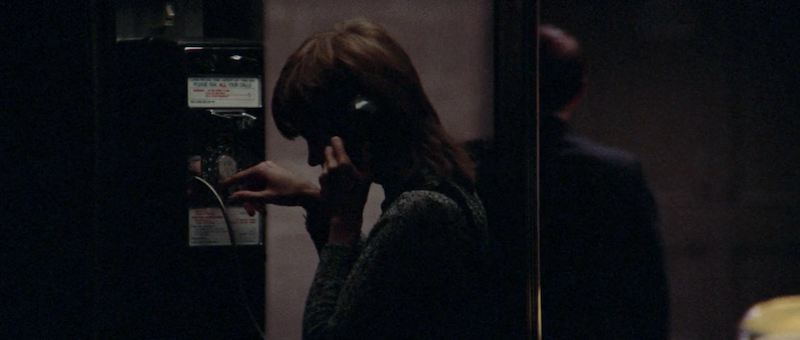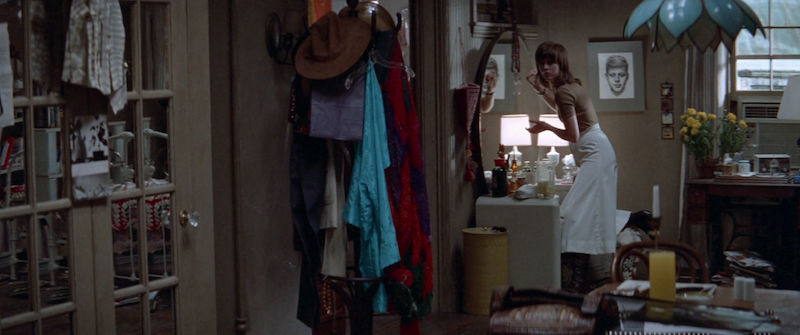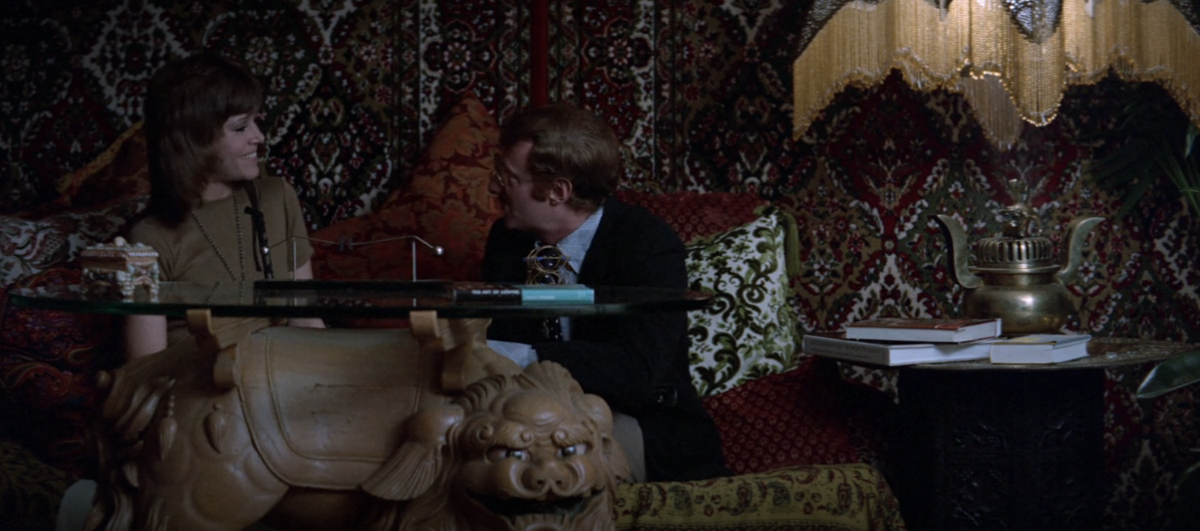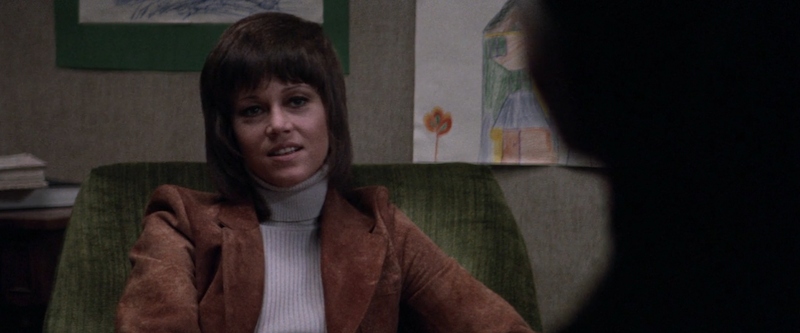Klute, pt 1: Auditions, Tricks, and Transformations
 Thursday, June 23, 2022 at 8:00PM
Thursday, June 23, 2022 at 8:00PM Occasionally we'll take a movie and baton pass it around the team and really dive in. If you missed past installments we've gone long and deep on Rebecca (1940), West Side Story (1961), Who's Afraid of Virginia Woolf (1966), Rosemary's Baby (1968), Cabaret (1972), Silence of the Lambs (1991), Thelma & Louise (1991), Aladdin (1992) and A League of Their Own (1992).
KLUTE
A Mini-Series Retrospective with "Best Shot" Choice
Part 1 by Nathaniel R

The Oscar winning thriller Klute (1971) is now just over a half-century old. Since it's a personal favourite of mine, and features the iconic Jane Fonda in her first Best Actress winning performance, it's high time we really gave it its due here at The Film Experience. So let's start from the beginning and dive into what makes it great. Along the way we'll pick a "Best Shot" from each section, too, to coincide with that series...
The screen marker times below are rough estimates since HBOMax weirdly includes a new two minute promo reel essentially advertising TCM and introducing the film as part of its actual running time?

00:04 The first shot of Klute is a tape recording device though what it's recording we do not know. Is it this dinner party we're interrupting? If so, good luck gleaning any information. True to life and in true 70s movie fashion -- it wasn't just Robert Altman -- everyone is talking over everyone else. All we can pretty much glean as the camera wanders across a table is that the party is for a guy named "Tom" who raises his glass to the camera, in a point of view shot from where his wife is sitting.

Did you know the subject Thomas Gruneman?
02:15 In a sobering cut, we're now looking at an empty chair (the one Tom sat in) and all that festive party sound has dropped out. The emotive power of a smart cut! The editor is the late Carl Lerner (12 Angry Men, Boys in the Band).
In this second expository scene, shot from the same angle as the party, three guests we saw there are discussing his disappearance: John Klute (Donald Sutherland) who we learn is both Tom's best friend and a policeman, Tom's wife Holly (Betty Murray), and Tom's colleague Peter Cable (Charles Cioffi) are being asked questions about the man. We learn he wrote several obscene letters to "a woman in New York City" and we're immediately excited. Not for the obscenity but for the actressing. See, we've seen Klute before so we know they're referencing Bree Daniels (Jane Fonda) which makes this a tingly thrill. If you've never seen the picture before, just wait.

3:31 The opening titles begin. "an ALAN J PAKULA Production". "JANE FONDA". "DONALD SUTHERLAND". KLUTE. The memorable serpentine score by Michael Small slithers around images of cords and wires and reel to reels and microphones recording the conversation. Jane Fonda's hypnotic carnal voiceover offers up the apple in response. Her services for the night. "Inhibitions are always nice because their so nice to overcome," she says with a canned non-girlish giggle.
 Silver - Runner up. Best shot in the film's first third.
Silver - Runner up. Best shot in the film's first third.

5:30 The first image after the title sequence is iconic. It's the first premonition that Klute, in addition to becoming a future classic thriller, will also inarguably become a seminal 'fashion film'. You can see Bree, third from the right, in all grey and stylish soon-to-be imitated haircut. When the casting directors walk by her they ask only to see her hands and move on immediately to the next girl with nary a word. Fonda is so good in this film that you can feel her anger beneath the practiced people-pleasing exterior. She smiles but as soon as they've passed by her her looks could kill though she barely moves a muscle. Pakula and his editor are very smart about this sequence. Though the film is moving swiftly to set the story up, note that they stay in this wide shot of the audition room longer than they have to. In fact they stay long enough to both watch Bree and the other rejects depart the shot entirely and stick around to observe a whole new parade of would-be models, this time women of color, line up to be treated to the same indignity. It doesn't help tell the story but it speaks volumes. The world's oldest profession may be harshly judged and illegal but women like Bree can have more control and command more respect in that line of work than in the reputable world of fashion.
We return briefly to the missing man's house again to learn that Klute will investigate the disappearance himself.
 Bronze - Second runner up for best shot from the film's first third.
Bronze - Second runner up for best shot from the film's first third.
7:30 While overlap between a sound from one scene and images from another scene are utterly common in movies, their most often deployed as brief transition, like a counterpart to the visual tactic of the dissolve. Here it's more than transition and an instrinsic part of the form. Perfect for a movie about surveillance. As the police debrief Klute at length on Bree's record, day to day activities (they've been tailing her) and their conversations, the camera stays with Bree the whole time. We watch her walking the city and making a phone call.
How beautiful is this silhouette shot, Bree still largely unknown to us beyond her sordid profession? But it's hard not to note the man with his back turned, unknown to Bree but surely following her.

9:45 In one of the film's funniest moments of sound editing we hear church bells playing as Fonda walks towards the camera with great purpose, braless in her dynamite grey ensemble, until she's out of focus; She's heading to her first john of the day. LOL.
Fonda is just astounding in this prostitution scene, as Bree makes constant hairpin turns to control of the conversation, present herself erotically, and fish as much as possible from the man's wallet. Fonda gives us peaks and asides to Bree's headspace while she's "performing", usually when the man's face is turned and she... shifts, or rushes a small talk response line. It's notably hard for actors to appear spontaneous in performance, given that, they have to know the lines and the scene intricately and have often done it multiple times. Now imagine staying in-the-moment this precisely, to the point that you read as utterly spontaneous and reactive to your scene partner, but also convey something quite the opposite, akin to mundane practiced routine. When Fonda whispers come ons, or goads her john into whispering what he wants to do to her, or expresses horny delight as his probably garden-variety desires, you believe every moment. Or at least you believe Bree in the way one believes a charismatic magician selling an illusion. We've heard in voiceover that Bree is successful, turning 600-700 tricks a year but in this moment, you understand her success.

11:50 On top of the precise but never detached physicality, her line readings are wildly smart, surprising, and inventive. Just the way she says "Chicago" with a fraction too much contempt, an involuntary flash of impatience as she waits for his money, is a masterclass. It all leads to an incredible physical punchline when she looks at her watch for a split second during an ecstatic moan, puncturing the eroticism like she's about to punch out on her time card. God level star acting, truly.

13:40 Love this bit of location scouting or art direction. When we finally go "Home" with Bree, as the camera pans up as she carries flowers up her steps we see that she lives next to a Funeral Home. This is a thriller after all -- a dead body or bodies will surface.

15:15 Alone at home, Bree randomly sings the Christian hymn "We Gather Together" while smoking a joint because why not? God bless 70s movies and their naturalism and idiocyncracies. Then she happily reads a Horoscope book. Fonda's body language as Bree when the woman is alone, whether walking in the streets or trying to relax at home is noticeably freer, with no target to seduce or impress.

17:02 The phone rings after midnight multiple times with no one answering on the other end. Bree looks unnerved as if this has happened before. That repetitive score begins again and perhaps calling it 'serpentine' was misleading. Perhaps it's closer to a demented music box? Though the camera is often static it pulls away slowly here as if it's a malevolence hovering and has chosen to retreat rather than be seen.
 George's choice for BEST SHOT - see his tweet
George's choice for BEST SHOT - see his tweet
18:00 Bree feeding her cat. But there's no cat. (Madonna also licks the cat food spoon in her "Bad Girl" video in 1992. Was than an homage?)

18:10 The door buzzer. Look at the character of Bree's studio apartment. There are almost as many interesting and ultra specific details as in Fonda's performance. A random drawing of John F Kennedy on the wall, clothes rack, fresh cut flowers, the candle from the night before, decorative lamps, random clutter, books, cat food, and the unwashed dishes.


- Who is it?
- My name is Klute, John Klute. I'd like to talk to you.
19:00 Not a meet cute. Klute is all awkward business and Bree is all sarcasm. Fonda has even thought through how Bree acts when she thinks she's being funny, doing a dumb Southern accent when asking for his identification. She refuses him.

-How do you feel about being an actress.
-Oh I like it very much, acting.
20:40 Another failed audition, compare this scene to her trick and marvel at how similar Bree's behavior is, as she tries to control and seduce but without the transactional power. She's more easily thrown and flustered but still rushes lines, attempting to speed things up or anticipate the man's needs.

For an hour I'm the best actress in the world.
23:15 Not for just an hour, Jane!
In this scene Bree meets with her psychiatrist and the script by Andy and David Lewis puts into so many words what we've been saying about the differences between Bree as a call girl and as an actress. In lesser hands this scene, which tells us everything Fonda has been revealing from performance alone, might have felt redundant. In Fonda's hands though it's yet more revealing. Bree thinks she knows herself but does she? Why is she so angry? Does she enjoy sex or just get off on its power? Why is she seeing a psychiatrist in the first place to rid her of the one thing she's so very confident and proud about and that pays her bills? About her tricks she says "I always feel just great afterwards"
26:00 Trick #2. Bree visits a frequent client. There's obvious role play happening as she tells an elaborate obviously made-up story about a sexual encounter with a young... no, middle-aged man, in Cannes as she slowly strips. The score, as if in cahoots and playing along, sounding nothing at all like the film's usual theme music just as Bree dresses and walks and speaks differently.

This is my choice for Best Shot (at least in the film's first third). Our point of view comes from Bree's regular john, an older man in a garment shop. Bree approaches in long wide shot, the camera then views her in a medium shot from the side, until this held shot which transforms as you watch it. It's a triumph of mise en scene as Bree wanders past vague suggestions of women via dress forms into a sort of abstract gauzy space and emerges in closeup as a new invented self. She could be anyone as a real actress; Is this role play for the john or for Bree herself?
The moody cinematography, which takes on a gauzy, even out of focus, hallucinatory feeling in the chosen shot, is by the master Gordon Willis who angered and confused people in his heyday with lighting that often obscured actors faces. The Oscars eventually caught up with an Honorary but his career includes only two competitive nominations (Zelig, The Godfather Part III) despite an astounding filmography chalk full of inimitable work in bonafide classics.

You bastard! Is this a shakedown hon'? Cuz you picked a loser, I don't have it.
30:00 Klute surprises Bree at her home. She sees he has evidence of her arrest record and assumes he's there for money but agrees to talk. We see a brief out of focus glimpse of someone watching them. Bree plays it cordial but irritated at his presence at first. She ditches the irritations, trying a different tactic "Try to get it from my side" and tells him her story. Two years previously she used to be a call girl full time and was living the glamorous life until the police came and destroyed everything, arresting her and asking questions about Gruneman and these letters she was receiving. She reiterates that she has never known what they were talking about apartment from remember the "sick" letters.
 This is Ryan's choice for BEST SHOT -- see his thread on Twitter
This is Ryan's choice for BEST SHOT -- see his thread on Twitter
Try seeing it from my side
32:30 Klute is watching her intently and Sutherland's ever watchable poker face mesmerizes as she continues to tell him about a guy who tried to kill her. But she can't identify him as Tom Gruneman. She's met so many men. "I can't identify him as anybody!".
What does he make of this woman? Does he believe her? And how will he react as she shifts tactics yet again to seduction as she leans in and suggests "a party" in exchange for the tapes of her voice. "Wouldn't that be nice"?

Tomorrow: Part Two with Ben Miller as John Klute and Bree Daniels get deeper in the weeds of the Bruneman mystery.
 Best Actress,
Best Actress,  Donald Sutherland,
Donald Sutherland,  Jane Fonda,
Jane Fonda,  Klute,
Klute,  Oscars (70s),
Oscars (70s),  sex workers,
sex workers,  thriller
thriller 


Reader Comments (5)
I've seen Klute twice, and it took me the 2nd watch to see the brilliance of the movie, and of Fonda.
At first she seemed too much herself, too smart, for a call girl role, and I didn't groove to its 70s storytelling.
The 2nd time, I saw it as the movie star performance it is, and the longer you stick with her and the movie, the grittier both reveal themselves to be.
The best shot here is stunning.
"Klute" is a great film and it's style by Alan Pakula and Gordon Willis has been tremendously influential. Willis took technicolor and gave it the moodiness of cinema noir.
I noticed in IMDB, Donald Sutherland said that they rehearsed from 8 am to 9 am, but then the lighting crew took until 1 pm before shooting began. Time well spent.
Some great shots in your article that really capture the claustrophobic tension of the movie.
OK, It's official. We're doing another Jane Fonda next season. Queen.
Adore Jane and Donald Sutherland in this. Reminds me that both were quite the artist in the 70's. Jane gives a star performance as Bree. One finds it so easy to accept her as the part. Donald Sutherland's taciturn cop is just the balance needed to offset Fonda's attempts to run the table.
I actually only watched this for the first time about a month ago. I have no idea if I watched it when it came out - but probably not, because I would have remembered it.
I saw "Jane Fonda on Stage" at the Fox Theater in San Francisco in 1979 or 1980. It was basically just her telling stories. The current Jane Fonda - with the face lifted - is quite good in Grace and Frankie.
This is so great - so glad you're doing this! Love your observations, especially on the silver-medal shot.
I watched Klute for the first time back last year (in anticipation of the 50th anniversary roundelay) and it really stuck with me. I think it may be my favorite of the Pakula "paranoia" trilogy, and Fonda definitely deserved that Oscar. Sutherland should've gotten a nod, too.